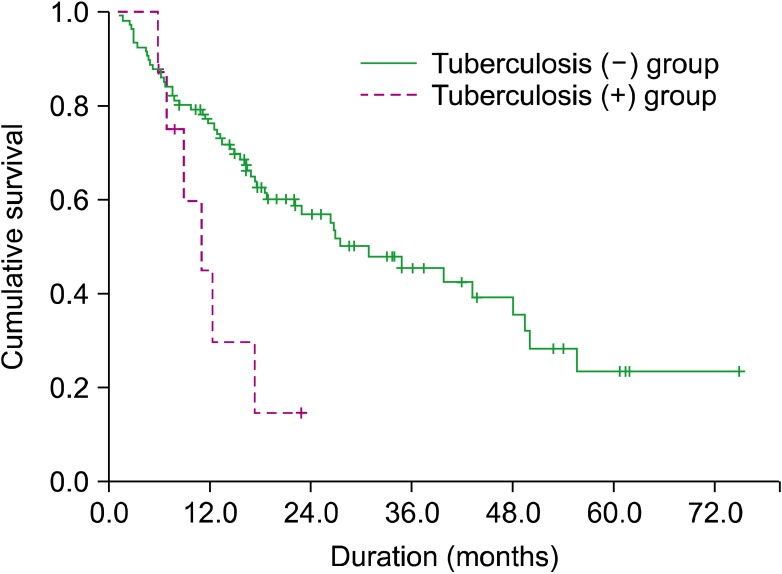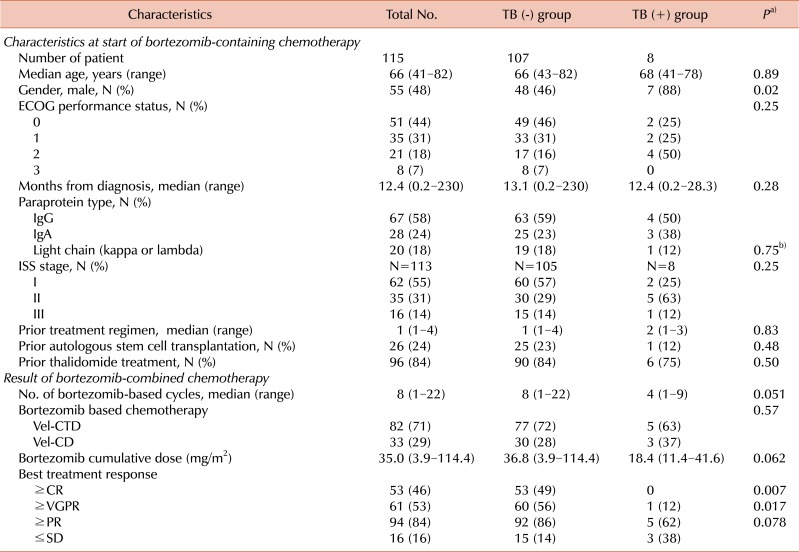1. Mazurek GH, Jereb J, Vernon A, LoBue P, Goldberg S, Castro K. Updated guidelines for using interferon gamma release assays to detect mycobacterium tuberculosis infection - United States, 2010. MMWR Recomm Rep. 2010; 59:1–25. PMID:
20577159.
2. Dolin PJ, Raviglione MC, Kochi A. Global tuberculosis incidence and mortality during 1990-2000. Bull World Health Organ. 1994; 72:213–220. PMID:
8205640.
3. Wu CY, Hu HY, Pu CY, et al. Aerodigestive tract, lung and haematological cancers are risk factors for tuberculosis: an 8-year population-based study. Int J Tuberc Lung Dis. 2011; 15:125–130. PMID:
21276308.
4. Ogawara H, Handa H, Yamazaki T, et al. High Th1/Th2 ratio in patients with multiple myeloma. Leuk Res. 2005; 29:135–140. PMID:
15607360.

5. Berges C, Haberstock H, Fuchs D, et al. Proteasome inhibition suppresses essential immune functions of human CD4+ T cells. Immunology. 2008; 124:234–246. PMID:
18217957.
6. Heider U, Rademacher J, Kaiser M, Kleeberg L, von Metzler I, Sezer O. Decrease in CD4+ T-cell counts in patients with multiple myeloma treated with bortezomib. Clin Lymphoma Myeloma Leuk. 2010; 10:134–137. PMID:
20371447.

7. Flynn JL, Chan J. Immunology of tuberculosis. Annu Rev Immunol. 2001; 19:93–129. PMID:
11244032.

8. Schütt P, Brandhorst D, Stellberg W, et al. Immune parameters in multiple myeloma patients: influence of treatment and correlation with opportunistic infections. Leuk Lymphoma. 2006; 47:1570–1582. PMID:
16966269.

9. Kim YK, Sohn SK, Lee JH, et al. Clinical efficacy of a bortezomib, cyclophosphamide, thalidomide, and dexamethasone (Vel-CTD) regimen in patients with relapsed or refractory multiple myeloma: a phase II study. Ann Hematol. 2010; 89:475–482. PMID:
19921192.

10. Rajkumar SV, Harousseau JL, Durie B, et al. Consensus recommendations for the uniform reporting of clinical trials: report of the International Myeloma Workshop Consensus Panel 1. Blood. 2011; 117:4691–4695. PMID:
21292775.

11. Schoeman JF, Fieggen G, Seller N, Mendelson M, Hartzenberg B. Intractable intracranial tuberculous infection responsive to thalidomide: report of four cases. J Child Neurol. 2006; 21:301–308. PMID:
16900926.

12. Stefan DC, Andronikou S, Freeman N, Schoeman J. Recovery of vision after adjuvant thalidomide in a child with tuberculous meningitis and acute lymphoblastic leukemia. J Child Neurol. 2009; 24:166–169. PMID:
19182153.

13. Gori A, Rossi MC, Marchetti G, et al. Clinical and immunological benefit of adjuvant therapy with thalidomide in the treatment of tuberculosis disease. AIDS. 2000; 14:1859–1861. PMID:
10985328.

14. Motoyoshi Y, Kaminoda K, Saitoh O, et al. Different mechanisms for anti-tumor effects of low- and high-dose cyclophosphamide. Oncol Rep. 2006; 16:141–146. PMID:
16786137.

15. Jick SS, Lieberman ES, Rahman MU, Choi HK. Glucocorticoid use, other associated factors, and the risk of tuberculosis. Arthritis Rheum. 2006; 55:19–26. PMID:
16463407.

16. Engelhardt M, Kleber M, Udi J, et al. Consensus statement from European experts on the diagnosis, management, and treatment of multiple myeloma: from standard therapy to novel approaches. Leuk Lymphoma. 2010; 51:1424–1443. PMID:
20509769.

17. Fauci AS, Braunwald E, Kasper DL, editors. Harrison's principles of internal medicine. 2008. 17th ed. New York, NY: McGraw-Hill Medical;p. 1006–1020.







 PDF
PDF ePub
ePub Citation
Citation Print
Print


 XML Download
XML Download